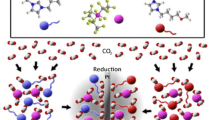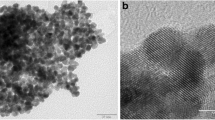Abstract
In addition to the orientation analyses of pure ionic liquids on an electrode surface, disclosure of the cationic effect of an ionic liquid in the generation of an electron transfer active mediator can have added advantages towards the removal of air pollutants. In this study, 1-butyl-3-methylimidizolium-bis-trifluoromethylsulfonylimide ([BMIM]NTF2) and 1-butyl-3-methylpyrrolidinium-bis-trifluoromethylsulfonylimide [BMPyr]NTF2 ionic liquids were used for the oxidation/reduction of Co(II) by cyclic voltammetry and impedance analyses. The initial redox behavior of Co(II) in the above two ionic liquids was identified and compared with that of the pure ionic liquids. The results showed that Co(II) reduction follows an adsorption-controlled electron transfer process and Co(II) oxidation follows a diffusion-controlled process. The [BMPyr]NTF2 ionic liquids showed stronger adsorption on a Pt electrode than [BMIM]NTF2. The charge transfer resistance (R CT) during the oxidation of Co(II) was determined to be higher in the [BMPyr]NTF2 ionic liquid. No capacitance variations with the applied potential in a [BMIM]NTF2 ionic liquid but the [BMPyr]NTF2 ionic liquid showed a negative charge below − 1.0 V and a positive charge beyond − 1.0 V. These results show that the [BMIM]NTF2 ionic liquid favors the generation of Co(III) and Co(I) mediator, but the [BMPyr]NTF2 ionic liquid favors the generation of the Co(I) mediator only.







Similar content being viewed by others
References
Dahm CE, Peters DG (1996) Catalytic reduction of α,ω-dihaloalkanes with nickel(I) salen as a homogeneous-phase and polymer-bound mediator. JElectroanalChem 406(1-2):119–129. https://doi.org/10.1016/0022-0728(95)04453-1
Ji C, Day SE, Silvers WC (2008) Catalytic reduction of 1- and 2-bromooctanes by a dinickel(I) Schiff base complex containing two salen units electrogenerated at carbon cathodes in dimethylformamide. JElectroanalChem 622(1):15–21. https://doi.org/10.1016/j.jelechem.2008.04.023
Kozub BR, Compton RG (2010) Voltammetric studies of the redox mediator, cobalt phthalocyanine, with regard to its claimed electrocatalytic properties. Sensor Actuat B-Chem 147(1):350–358. https://doi.org/10.1016/j.snb.2010.02.062
Govindan M, Moon I-S (2013) A single catalyst of aqueous CoIII for deodorization of mixture odor gases: a development and reaction pathway study at electro-scrubbing process. JHazardMater 260:1064–1072. https://doi.org/10.1016/j.jhazmat.2013.06.055
Nzikou JM, Aurousseau M, Lapicque F (1995) Electrochemical investigations of the Ce(III)/Ce(IV) couple related to a Ce(IV)-assisted process for SO2/NOx abatement. J Appl Electrochem 25:967–972
Muthuraman G, Chung SJ, Moon IS (2011) The combined removal of methyl mercaptan and hydrogen sulfide via an electro-reactor process using a low concentration of continuously regenerable ag(II) active catalyst. JHazardMater 193:257–263. https://doi.org/10.1016/j.jhazmat.2011.07.054
Bringmann J, Ebert K, Galla U, Schmieder H (1997) Oxidative separation of nitrogen oxides from off-gases by electrochemical mediators. JApplElectrochem 27(7):870–872. https://doi.org/10.1023/A:1018489232316
Muthuraman G, Ramu AG, Moon IS (2016) Gaseous trichloroethylene removal using an electrochemically generated homogeneous low-valent ligand-free co(I) electrocatalyst by electro-scrubbing. JHazardMater 311:210–217. https://doi.org/10.1016/j.jhazmat.2016.03.011
Muthuraman G, Moon IS (2016) Sustainable generation of a homogeneous Ni(I) catalyst in the cathodic compartment of a divided flow electrolytic cell for the degradation of gaseous carbon tetrachloride by electroscrubbing. ACS Sustain Chem Eng 4(3):1364–1372. https://doi.org/10.1021/acssuschemeng.5b01383
Govindan M, Gopal RA, Moon IS (2017) Efficient removal of gaseous trichloroethylene by continuous feed electro-scrubbing using a new homogeneous heterobimetallic electro-catalyst. ChemEngJ 308:1145–1153. https://doi.org/10.1016/j.cej.2016.09.137
O'Mahony AM, Silvester DS, Aldous L, Hardacre C, Compton RG (2008) Effect of water on the electrochemical window and potential limits of room-temperature ionic liquids. JChem Eng Data 53(12):2884–2891. https://doi.org/10.1021/je800678e
Welton T (1999) Room-temperature ionic liquids. Solvents for synthesis and catalysis. ChemRev 99(8):2071–2084. https://doi.org/10.1021/cr980032t
MacFarlane DR, Seddon KR (2007) Ionic liquids progress on the fundamental issues. AustJChem 60(1):3–5. https://doi.org/10.1071/CH06478
Watanabe M, Thomas ML, Zhang S, Ueno K, Yasuda T, Dokko K (2017) Application of ionic liquids to energy storage and conversion materials and devices. ChemRev 117(10):7190–7239. https://doi.org/10.1021/acs.chemrev.6b00504
Kaur N (2017) Ionic liquids: promising but challenging solvents for the synthesis of N-heterocycles. Mini-rev. Org Chem 14:3–23
Vander Hoogerstraete T, Wellens S, Verachtert K, Binnemans K (2013) Removal of transition metals from rare earths by solvent extraction with an undiluted phosphonium ionic liquid: separations relevant to rare-earth magnet recycling. Green Chem 15(4):919–927. https://doi.org/10.1039/c3gc40198g
Baldelli S (2008) Surface structure at the ionic liquid-electrified metal interface. Acc Chem Res 41(3):421–431. https://doi.org/10.1021/ar700185h
Johnson CM, Baldelli S (2014) Vibrational sum frequency spectroscopy studies of the influence of solutes and phospholipids at vapor/water interfaces relevant to biological and environmental systems. ChemRev 114(17):8416–8446. https://doi.org/10.1021/cr4004902
Lockett V, Sedev R, Ralston J, Horne M, Rodopoulos T (2008) Differential capacitance of the electrical double layer in imidazolium-based ionic liquids: influence of potential, cation size, and temperature. JPhysChemC 112(19):7486–7495. https://doi.org/10.1021/jp7100732
Rivera-Rubero S, Baldelli S (2004) Surface spectroscopy of room-temperature ionic liquids on a platinum electrode: asum frequency generation study. JPhysChemB 108(39):15133–15140. https://doi.org/10.1021/jp048260g
Islam MM, Alam MT, Ohsaka T (2008) Electrical double-layer structure in ionic liquids: a corroboration of the theoretical model by experimental results. JPhysChemC 112(42):16568–16574. https://doi.org/10.1021/jp8058849
Lauw Y, Horne MD, Rodopoulos T, Leermakers FAM (2009) Room-temperature ionic liquids: excluded volume and ion polarizability effects in the electrical double-layer structure and capacitance. PhysRevLett 103(11):117801. https://doi.org/10.1103/PhysRevLett.103.117801
Jagadeeswara Rao C, Venkatesan KA, Nagarajan K, Srinivasan TG, Vasudeva Rao PR (2010) Electrochemical and thermodynamic properties of europium(III), samarium(III) and cerium(III) in 1-butyl-3-methylimidazolium chloride ionic liquid. JNuclMater 399(1):81–86. https://doi.org/10.1016/j.jnucmat.2010.01.005
Xu M, Ivey DG, Xie Z, Qu W (2013) Electrochemical behavior of Zn/Zn(II) couples in aprotic ionic liquids based on pyrrolidinium and imidazolium cations and bis(trifluoromethanesulfonyl)imide and dicyanamide anions. ElectrochimActa 89:756–762. https://doi.org/10.1016/j.electacta.2012.11.023
Zhao C, Burrell G, Torriero AAJ, Separovic F, Dunlop NF, MacFarlane DR, Bond AM (2008) Electrochemistry of room temperature protic ionic liquids. JPhysChemB 112(23):6923–6936. https://doi.org/10.1021/jp711804j
Yoshii K, Oshino Y, Tachikawa N, Toshima K, Katayama Y (2016) Electrochemical reaction of bis(acetylacetonato)palladium in an amide-type ionic liquid. ECS Trans 75(15):517–524. https://doi.org/10.1149/07515.0517ecst
Gaillon L, Bedioui F (2004) Voltammetric analysis of the catalytic reactivity of electrogenerated CoI–salen with organohalogenated derivatives in an ionic liquid at room temperature. JMolCatalA-Chem 214(1):91–94. https://doi.org/10.1016/j.molcata.2003.10.062
Sweeny BK, Peters DG (2001)) Cyclic voltammetric study of the catalytic behavior of nickel(I) salen electrogenerated at a glassy carbon electrode in an ionic liquid (1-butyl-3-methylimidazolium tetrafluoroborate, BMIM+BF4 −). ElectrochemCommun 3(12):712–715. https://doi.org/10.1016/S1388-2481(01)00249-1
Lagunas MC, Silvester DS, Aldous L, Compton RG (2006) The electrochemistry of vitamin B12 in ionic liquids and its use in the electrocatalytic reduction of vicinal dibromoalkanes. Electroanalysis 18(22):2263–2268. https://doi.org/10.1002/elan.200603645
Honores J, Quezada D, Garcia M, Calfuman K, Muena JP, Aguirre MJ, Arevalo MC, Isaacs M (2017) Carbon neutral electrochemical conversion of carbon dioxide mediated by [Mn+(cyclam)Cln] (M = Ni2+ and Co3+) on mercury free electrodes and ionic liquids as reaction media. Green Chem 19(4):1155–1162. https://doi.org/10.1039/C6GC02599D
Balaji S, Kannan K, Moon IS (2015) The electrochemical oxidation of toluene catalysed by co(II) in N-butyl-N-methylpyrrolidinium bis(trifluoromethylsulfonyl)imide. PhysChemChemPhys 17(46):30983–30987. https://doi.org/10.1039/C5CP04151A
Shen Y, Inagi S, Atobe M, Fuchigami T (2013) Electrocatalytic debromination of open-chain and cyclic dibromides in ionic liquids with cobalt(II)salen complex as mediator. ResChemIntermediat 39(1):89–99. https://doi.org/10.1007/s11164-012-0634-6
Xiao L, Johnson KE (2003) Electrochemistry of 1-butyl-3-methyl-1H-imidazolium tetrafluoroborate ionic liquid. JElectrochemSoc 150(6):E307–E311. https://doi.org/10.1149/1.1568740
Tang Y, Wang Z, Chi X, Sevilla MD, Zeng X (2016) In situ generated platinum catalyst for methanol oxidation via electrochemical oxidation of bis(trifluoromethylsulfonyl)imide anion in ionic liquids at anaerobic condition. JPhysChemC 120(2):1004–1012. https://doi.org/10.1021/acs.jpcc.5b09777
Rogers EI, Huang X-J, Dickinson EJF, Hardacre C, Compton RG (2009) Investigating the mechanism and electrode kinetics of the oxygen|superoxide (O2|O2 •−) couple in various room-temperature ionic liquids at gold and platinum electrodes in the temperature range 298−318 K. JPhysChemC 113(41):17811–17823. https://doi.org/10.1021/jp9064054
Zhao C, Bond AM, Lu X (2012) Determination of water in room temperature ionic liquids by cathodic stripping voltammetry at a gold electrode. AnalChem 84(6):2784–2791. https://doi.org/10.1021/ac2031173
Xu M, Ivey DG, Xie Z, Qu W, Dy E (2013) The state of water in 1-butly-1-methyl-pyrrolidinium bis(trifluoromethanesulfonyl)imide and its effect on Zn/Zn(II) redox behavior. ElectrochimActa 97:289–295. https://doi.org/10.1016/j.electacta.2013.03.027
Tułodziecki M, Tarascon JM, Taberna PL, Guéry C (2014) Importance of the double layer structure in the electrochemical deposition of co from soluble Co2+− based precursors in ionic liquid media. ElectrochimActa 134:55–66. https://doi.org/10.1016/j.electacta.2014.03.042
Elbourne A, McDonald S, Voïchovsky K, Endres F, Warr GG, Atkin R (2015) Nanostructure of the ionic liquid–graphite stern layer. ACS Nano 9(7):7608–7620. https://doi.org/10.1021/acsnano.5b02921
Rusling JF (1994) Electroanalytical chemistry. In: Bard AJ (ed) A series of advances, vol 18. Dekker, New York, pp 1–77
Grahame DC (1947) The electrical double layer and the theory of electrocapillarity. Chem Rev 41(3):441–501. https://doi.org/10.1021/cr60130a002
Bockris JO, Reddy AKN (1998) Modern electrochemistry: fundamentals ofelectrodics, Vol.2 (2nd ed.), Kluwer. Plenum Press, New York
Bard AJ, Faulkner LR (2001) Electrochemical methods, 2nd edn. John Wiley and Sons, New York
Bockris JO, Reddy AKN (1998) Modern electrochemistry: Ionics, Vol.2, 2nd edn. Plenum Press, New York
Grahame DC (1950) Effects of dielectric saturation upon the diffuse double layer and the free energy of hydration of ions. J Chem Phys 18(7):903–912. https://doi.org/10.1063/1.1747807
Acknowledgments
This study was supported by the Sunchon National University Research Fund in 2016.
Author information
Authors and Affiliations
Corresponding author
Rights and permissions
About this article
Cite this article
Muthuraman, G., Kannan, K. & Moon, I.S. Effect of cation-containing RTIL on the Co(II) redox behavior towards homogeneous electron mediator generation. Ionics 24, 2877–2884 (2018). https://doi.org/10.1007/s11581-017-2388-z
Received:
Revised:
Accepted:
Published:
Issue Date:
DOI: https://doi.org/10.1007/s11581-017-2388-z




